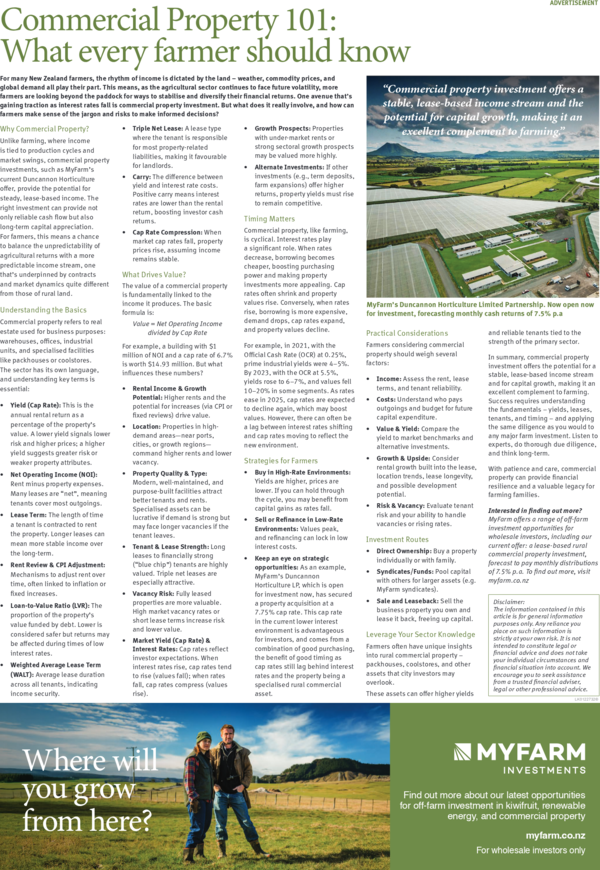‘V’ for Volatility
New Zealand farmers are no strangers to risk, with every season bringing its own set of challenges: milk payout swings, weather extremes, rising input costs, and regulatory changes, just to name a few. For decades, the strategy has been simple: own more land, milk more cows or run more cattle, and ride out the cycles. However, in the current climate, depending exclusively on dairy or sheep and beef farming leaves families vulnerable to broad, industry-wide risks that remain outside the control of even the most skilled producers.
Consider the last decade. The dairy payout has ranged from $3.90/kgMS to $10.16/kgMS. Lamb prices have increased from $115 per head to close to $200 per head. Fertiliser and feed costs have surged by 40–60% in some years. Climate variability is increasing, with droughts here and overseas impacting on supply, demand, pricing and farm profitability.
When your entire wealth and income depend on the success of one or two commodities, you’re effectively betting the farm on forces outside your control.
While this is the ‘lot’ of being a farmer, there are other options for businesses generating profits and free cashflow to contemplate growth and diversification.
Diversification as Insurance
Diversification isn’t about abandoning farming, it’s about protecting what you’ve built.
Think of it as an insurance policy that pays you back. By allocating a portion of equity into off-farm assets, farmers can create a second or third-income stream that has the potential to cushion against downturns and provide for the future.
There are several compelling reasons why diversifying into off-farm investments is worth considering today.
First, investment in assets such as kiwifruit orchards, solar projects, forestry and commercial property can be obtained through managed funds, providing farmers with a diversified source of income, potentially helping to stabilise cash flow when agricultural returns fall.
Second, these sectors are backed by their own robust market fundamentals. Demand for healthy fruit products continues to grow globally, with the shift towards electrifying our total energy system utilising renewable energy accelerating, and despite some changes to regulations, mixed use forestry still appears an important contributor to the economy to 2050 and beyond.
A third advantage is this: some investments are quite tax efficient, which might be welcome at times of higher on-farm incomes. For example, an investment in solar can provide cash returns without taxable income over the first ten years due to depreciation allowances on solar panels and related materials.
These all point to income sources outside of farming potentially improving financial flexibility for major life events. Whether it’s planning for succession, preparing for retirement, or ensuring fair settlements among family members who are not involved in the farm, off-farm income can help to make these transitions smoother and less stressful for you.
Case Study: A Farmer’s Hedge
A Waikato farming family with $10 million in equity, with an allocation of 10% ($1.0 million) into a kiwifruit fund investment and a solar fund.
- Annual forecast distributions from off-farm investments: $70,000 –90,000 combined.
- Exposure to SunGold kiwifruit and Zespri returns and renewable energy, not just milk/meat prices.
- Flexibility: If income drops from the farmer’s own property, the orchard and solar returns can help supplement lost income.
- Future optionality: these are separate assets to the farming business and as such can help support family during retirement which could be useful assets when it comes to succession planning.
Practical Steps to Start
Clarify priorities: Is the surplus intended for debt reduction, farm development, family needs, expansion, or off-farm investment? Each goal has a different risk and return profile. A good place to start is understanding your cashflow and benchmarking your performance and debt levels.
Evaluate Debt Reduction: Paying down high-interest or short-term debt increases liquidity and reduces the product price at which your farm breaks even.
Consider On-Farm Investment. Invest in projects with proven payback at conservative prices (e.g. pasture improvement, water reliability, effluent systems).
Ensure you have a buffer: Hold enough cash to cover operating costs through unexpected events before chasing higher returns.
Explore Off-Farm Investment Diversification: To reduce exposure to farming cycles, weather, and sector shocks, these assets can be more easily split among family members or used to support retirement and may offer tax efficiencies.
Set an allocation target: Start small, 5–10% of equity may be enough to make a difference.
Engage Trusted Partners and Advisors. Work with financial planners, investment syndicates, and sector experts to tailor strategies to your risk tolerance and goals. Make sure the risks of any investment are well known and there are mitigations in place.
Document and Communicate the Plan. Ensure investments fit with family wills and keep all stakeholders informed.
Monitor and Review Regularly. Review investments and farm projects against benchmarks and adjust as needed. Be agile and reallocate capital as market conditions and family needs evolve.
There is no one-size-fits-all response when it comes to managing any free cashflow that your are generating. The best strategy is one that aligns closely with your family’s unique objectives, appetite for risk, and available resources. In New Zealand, many farmers are choosing a balanced approach by continuing to focus on their core farming operations while also seeking new opportunities to diversify their income. Achieving long-term success in this area requires careful planning, thorough market research, and the guidance of trusted professionals.
MyFarm offers a range of off farm investment opportunities to wholesale investors, including our current offer, Duncannon Horticulture LP: a lease-based rural commercial property investment, forecast to pay monthly distributions of 7.5% p.a

Disclaimer:
The information contained in this article is for general information purposes only. Any reliance you place on such information is strictly at your own risk. It is not intended to constitute legal or financial advice and does not take your individual circumstances and financial situation into account. We encourage you to seek assistance from a trusted financial adviser, legal or other professional advice.



